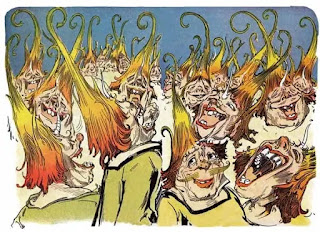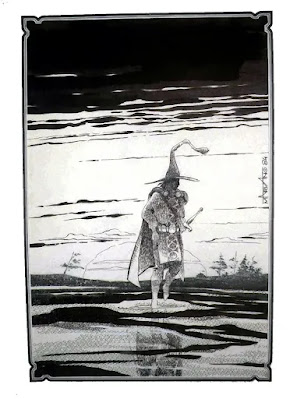Wednesday, December 6, 2023
Wednesday Comics: DC, March 1983 (week 1)
Monday, December 4, 2023
Under Compulsion in Phaelorn Gap
- Antor Hogus (Paul) - Vagabond with a stun gun and a dislike of authority, worse now than ever!
- Nortin Tauss (Aaron) - An arcane dabbler just trying to get by.
- Yzma Vekna (Andrea) - A grubby teamster watching things spiral out of control.
Thursday, November 30, 2023
Oz and the Dying Earth
Driving over the Thanksgiving holiday my family listened to the audiobook of The Patchwork Girl of Oz, and I was struck by how similar Baum's Oz stories are and some of Vance's work, particularly the Dying Earth related material. Some of it, of course, would be resemblances shared with other works of fantasy, but I think there is much more homology of Baum with Vance than say Howard, Smith, or Martin.
I've mentioned before the list of the elements of Vance's Dying Earth stories as outlined in Pelgrane Press' Dying Earth rpg:
- Odd Customs
- Crafty Swindles
- Heated Protests and Presumptuous Claims
- Casual Cruelty
- Weird Magic
- Strange Vistas
- Ruined Wonders
- Exotic Food
- Foppish Apparel
Some of those I think are present in Baum's Oz books, but there are others that have analogs. These are the ones that I think are most prominent:
Odd Customs. In the Dying Earth this relegated to cultural practices. In Oz, the people themselves may be odd not unlike the mythological peoples seem in Medieval or ancient travel tales. Still, the central aspect of using a culture taken to the absurd as an object of satire is present.
Weird Magic. This is all over the place in Oz, with many of the protagonists being products of it. The powder of life made by the Crooked Magician or the "Square Meal Tablets" certainly count.
Strange Vistas. Exploration is as important part of Oz as the Dying Earth. The weird underground world of the vegetable Mangaboos lit by glowing glass orbs in the sky would count, as would the the Land of Naught where the wooden gargoyles dwell.
Ruined Wonders. Oz doesn't have many ruins, but they do have Hidden Wonders, like the city of the China Dolls or the radium decorated city of the subterranean Horners.
Foppish Apparel. It isn't emphasized as much in the text, but it goes through in the illustration...
The other elements are less present in Oz, but Heated Protests/Presumptuous Claims has its analog in humorous exchanges and bickering. Oz isn't as cruel a place as the Dying earth--it shows up in children's stories after all--but it isn't without cruelty. It's a cruelty of the fairytale sort really where axes enchanted by witches might chop off a woodsman's limbs and an evil queen might desire a little girl's head enough to have it cut off.
There are other similarities not really accounted for here. Outlandish, unnatural monsters haunt the wilderness in both (and in both they are often capable of speech). Habitations are separated by wilderness and isolated cultures seem to exist along well-travelled roads. For the most part the societies of both settings seem fairly static (Oz a bit less so than the Dying Earth), in contrast to epic fantasies where world-changing events are part of the narrative. Overall, I think these could be summed up is that both settings seem perhaps descended from fairy stories, Oz more directly, and the Dying Earth through the fantasies of Smith, Cabell, and (maybe) Dunsany.
Wednesday, November 29, 2023
Wednesday Comics: DC, February 1982 (week 4)
Monday, November 27, 2023
Black Star and the Light of Xaryxis
As a break from our Land of Azurth 5e game, I decided a wanted to run a loose, more space opera adaptation of the Spelljammer adventure Light of Xaryxis. After considering the Star Raiders action flick of Outgunned and some other fairly light space opera games, I settled on Black Star from LakeSide Games. Mainly, I felt like trying something new, but it's even lighter than Outgunned, I think, and made for Space Opera.
The system uses a simple 2d6 roll to resolve tasks, though characters can spend Resolve (which also serves as Stress/Hit Points) to either reroll or move a failure to a partial success or a success to a greater success. It also has only player rolls and minion rules, both things I've enjoyed in Broken Compass/Outgunned.
It's only about $5 on drivethru, so worth checking out if that sort of system sounds interesting to you.
Anyway, we only did characters this session, but I'm looking forward to bringing a touch of Star Wars ripoff space opera in the vein of Battle Beyond the Stars and Micronauts to Light of Xaryxis.
Friday, November 24, 2023
Some Observations on Science Fiction Names
I think there is a lineage of science fiction name coining that whose progenitor is Edgar Rice Burroughs' Mars stories but that passes through early to mid-20th Century pulpier sci-fi like the works of Edmond Hamilton and Jack Vance to the galaxy far, far away of the Star Wars Universe.
In his Mars stories Burroughs went for relatively short (mostly 1-2 syllable), two part, phonetically simple names. Though they don't mostly sound that way to modern ears, I suspect Burroughs was after what he thought of as an "Oriental" feel. They also wind up being very simple for English speaking readers to pronounce. Examples: Kantos Kan, Gan Had, Ras Thuvas, Sab Than, Sojat Yam.
Burroughs uses a not hugely different style in many of his Planetary Romances.
Edmond Hamilton was clearly influenced by Burroughs in a number of ways and the naming practices in several of his works are similar, though they are a bit more phoentically diverse and have more consonant blends. Here are some names from his Captain Future series: Sus Urgal, Re Elam, Thuro Thuun, Rok Olor, Si Twih, Brai Balt
Typically, he doesn't always try to be so "exotic." Sometimes he seems to be trying to convey future developments of English names. This tact he shares with other writers of the 1940s-1960s, including the various creators of the members of the Legion of Super-Heroes in DC Comics: Irma Ardeen, Rok Krinn, Garth Ranzz, Tinya Wazzo.
Jack Vance tends to take this latter approach in some of his science fiction, too, though his names are more often multisyllabic and have a first-name last name pattern with each name sometimes made up of more than one element. Still, they have a similar vibe I think to the Hamilton and Legion names. These are from the first two Demon Princes novels: Miro Hetzel, Conwit Clent, Lens Larque, Sion Trumble, Kokor Hekkus, Kirth Gersen.
Star Wars names aren't the product of one individual, though later writers have obviously tried to fit the standards of the original trilogy. There are more straight up English names in Star Wars and of course some pseudo-Japanese ones, but a number could easily have been characters in Captain Future stories, like these: Ric Ole, Sio Bibble, Pondo Baba, Plo Kloon, Nien Nunb, Mace Windu, Sy Snootles.
Monday, November 20, 2023
Occurrences in the Night in and Around Phaelorn Gap
- Antor Hogus (Paul) - Vagabond with a stun gun and now a chatty quaklu
- Nortin Tauss (Aaron) - An arcane dabbler, skeptical of Hogus' decisions
- Yzma Vekna (Andrea) - A grubby teamster trying to be the voice of reason
- Jerfus Grek (Jason) - A vagabond, but fat where Hogus is lean, and possessed of a kaleidoscopic cloak































